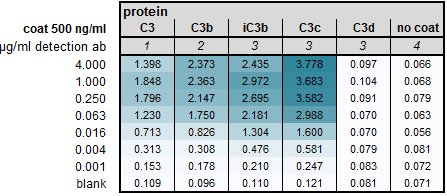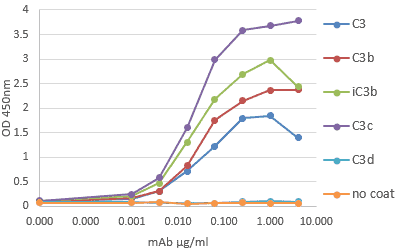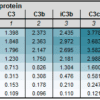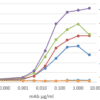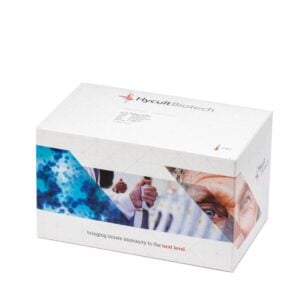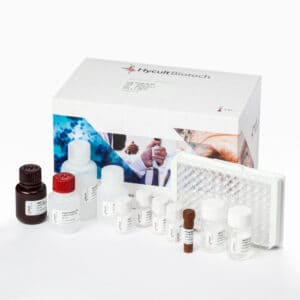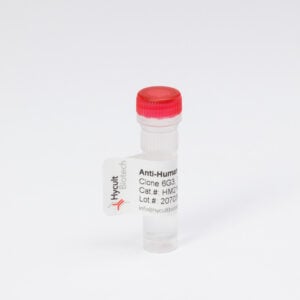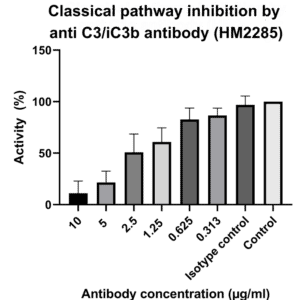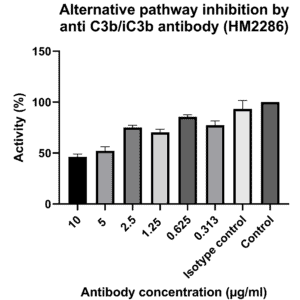C3, C3b, iC3b, C3c, Human, clone C3-16.4
The antibody clone C3-16.4 recognize complement C3, C3b, iC3b and C3c. The recognition domain is determined to MG2-MG6. The antibody blocks alternative pathway C3-covertase formation.
Read more€133.00 €414.00Price range: €133.00 through €414.00
Understanding the Complement System: Focus on C3, C3b, iC3b, and C3c
The complement system is a critical component of both innate and adaptive immune responses. It initiates an inflammatory and protective reaction to pathogens, providing an early line of defense before an adaptive immune response is generated. This system comprises a complex family of proteins and receptors present in circulation, tissues, and various body fluids. Among these, the components C3, C3b, iC3b, and C3c play pivotal roles.
Pathways of Complement Activation: The Role of C3 and Its Fragments
Activation of the complement system can occur through three pathways: the classical pathway, triggered by immune complexes; the lectin pathway, initiated by surface-bound lectins; and the alternative pathway (AP), activated by surfaces not specifically protected against it. Each pathway leads to the formation of a C3 convertase, a serine protease that cleaves the central complement protein C3. This cleavage generates the major fragment C3b, a key player in the complement cascade.
The Dynamics of C3, C3b, iC3b, and C3c in Immune Response
The C3 and C5 convertases are enzymatic complexes that drive the activity of complement pathways, culminating in the formation of the cytolytic membrane attack complex (MAC). C3 synthesis is tissue-specific and modulated by various stimuli. Upon cleavage by C3 convertase, C3a and C3b are formed, with C3b capable of undergoing further degradation into iC3b, C3c, C3dg, and C3d in the presence of complement regulatory molecules.
C3c: A Stable Biomarker in Complement-Mediated Immunity
Unlike other C3 fragments, C3c does not bind to structures like pathogens, cell surfaces, or plasma proteins, making it a stable and reliable complement biomarker. It remains solely in the fluid phase, free from interference by other C3-based products. C3 is mainly produced by the liver, but also by macrophages, neutrophils, endothelial, and epithelial cells. Its high levels in circulation and low biological reactivity enable a rapid and potent response to threats like pathogens.
Clinical Implications of C3 and Its Fragments
Deficiencies or defects in C3 can lead to recurrent infections or autoimmune diseases. C3 deficiency, though rare, results in recurrent infections and impaired immune cell development. Polymorphisms in C3 are linked to diseases like age-related macular degeneration (AMD) and atypical hemolytic uremic syndrome (aHUS). Beyond pathogen clearance, C3 and its fragments assist in the removal of immune complexes, aiding macrophage phagocytic capacity. Dysfunctions in this system can lead to autoimmune diseases and complement deposition in tissues.
Not sure which C3 antibody to use?
With numerous options available, it is essential to select the right C3 antibody to ensure the success of your research. We designed a guide to assist you in making an informed decision:
Go to our C3 researcher’s guide and choose the right antibody
FS: the antibody blocks the formation of C3 convertase by alternative pathway (Ref.1)
C3-16.4 recognizes a region around MG2 and MG6, and projects outward the C3b molecule (Ref.1)
You may also like…
-
View product €756.00 €1,223.00Price range: €756.00 through €1,223.00
-
View product €894.00 €1,443.00Price range: €894.00 through €1,443.00
-
C3d, Human, ELISA kit
Cross reactivityCynomolgus monkey – Yes, Horse – No, Mouse – No, Pig – No, Rat – NoView product €894.00 €1,443.00Price range: €894.00 through €1,443.00
You may be interested in…
-
View product €133.00 €1,245.00Price range: €133.00 through €1,245.00
-
View product €133.00 €8,873.00Price range: €133.00 through €8,873.00
-
View product €133.00 €8,873.00Price range: €133.00 through €8,873.00
-
View product €133.00 €456.00Price range: €133.00 through €456.00
